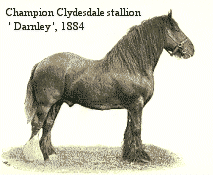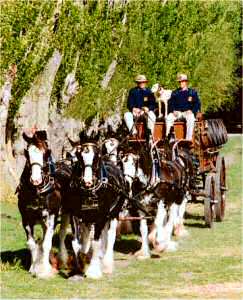|
CLYDESDALES DOWN UNDER
|
|||
|
HOME | BIOLOGY | FILMS | GEOGRAPHY | HISTORY | INDEX | MUSIC | SOLAR BOATS | SPORT | SPONSORS |
|||
|
The valley of the Clyde River, in Lanarkshire, Scotland, is the original home of the Clydesdale, the best known in New Zealand of the British and European heavy draught horses. Its development can be traced back to the early eighteenth century when, with the cessation of warfare, the need arose for a horse with pulling power which could assist in the development of agriculture. It is known that Flemish stallions were imported to grade up and improve upon the Scottish animals already available in the Clyde area, as well as some English 'black horses' (see » Shire Horses). It is clear that the Clydesdale's development was not due to the influence of any single outstanding sire but to the careful breeding of a selection of outstanding horses to the strong, heavy, but relatively small native mares of the area.
The Clydesdale Horse Society was founded in 1877 – followed by publication of the first Stud Book. And the Glasgow Agricultural Society greatly assisted in the promotion of the breed with its annual spring Clydesdale Stallion Show. During the latter half of the nineteenth century there was an increase in the export of the breed to overseas countries, and it was at this period that the Clydesdale was imported into New Zealand. (As early as 1849, draught horses, including "Clydes" were being recommended by settlers in preference to oxen for ploughing in Canterbury.) Their increase over the next fifty years reflected advances in agriculture. In 1918 a survey showed that Canterbury (which had the highest number of horses in New Zealand) had a total of 66,582 of all breeds, of which 43,199, or 65%, were listed as "draught". Of these, the greatest number would have been Clydesdales or Clydesdale crosses. There was a similar percentage in other agricultural provinces. Otago, with its Scottish settlements, became the breeding centre for draught horses, and not surprisingly the Clydesdale predominated.
The years following the First World War saw a steady decline in Clydesdale numbers with the ever-increasing use of tractors on farms and with motorized vehicles such as trucks slowly replacing carts and drays. This decline occurred in Britain as well as in Australia, New Zealand, and other countries to which the breed had been exported in its heyday. A Clydesdale which in New Zealand had been worth £65 after the First World War, by the 1930s could be bought for around £15. Shortly after the Second World War an historian was told that he would not be able to see a six-horse draught team working anywhere in New Zealand, and classes for draught animals were discontinued at many local A&P (Agricultural and Pastoral Society) shows.
New Zealand Clydesdales However, since the 1990s, the Clydesdale Horse Society of New Zealand has had a steadily increasing membership, with a parallel increase in the number of horses. Enthusiasts exist throughout the country, and the horses are a great attraction at most of the large A&P shows.
Despite its size (it is one of the world's largest horses) the Clydesdale is an active horse with a clean, bright movement, combined with a mild temperament. It should be well built, muscular and powerfully vigorous – its primary role, after all, is as a draught animal, designed to pull heavy loads – especially carts and ploughs.
The most common colours are bay and brown, usually with a white face or 'blaze', and a lot of white on the lower legs. One of the Clydesdale's most distinctive characteristics is the extensive, silky feathering on the legs. The cascading, flowing movement of this, as the Clydesdale moves, is one of the breed's most attractive features.
Of great significance in bringing the breed back to public notice was the spectacular brewery team, the "DB Draught Clydesdales" – rare, black horses with white legs. The team travelled all over New Zealand for fourteen years, and now operates in private ownership as the Pirongia Clydesdales (see photo above).
|
|||
|
HORSE SANCTUARY UK LIMITED is a company with charitable objects Registered in England and Wales No. 4593172
|
|||
|
AUTOMOTIVE | BLUEBIRD | ELECTRIC CARS | ELECTRIC CYCLES | SOLAR CARS |

